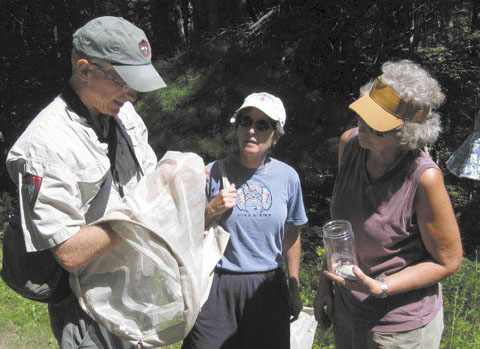JEFFERSON — Most people don’t know just what exactly distinguishes a butterfly from a moth.
Thanks to the Maine Butterfly Survey, a group of wildlife enthusiasts found out the difference last week. Butterflies have a knob on their antennae; moths do not.
This and a slew of other butterfly-related facts were presented by Phillip deMaynadier, wildlife biologist for the Maine Department of Inland Fisheries and Wildlife and the survey, at the Hidden Valley Nature Center on the Jefferson-Alna border.
DeMaynadier began with the fact that moths are 10 times more diverse than butterflies, then led the group through the life cycle of a monarch.
Most in attendance were surprised to learn that the same butterflies that leave Maine for central Mexico in the fall do not return; it’s their offspring that make the return flight.
Later, he described unique subgroups of Maine butterflies, ranging from the small and drab skippers to the stunning gossamer wings.
One, the spicebush swallowtail, was thought to be extinct in Maine, he said, but now appears to be making a comeback. According to deMaynadier, 20 percent of Maine species are either endangered, threatened or extinct.
He has high hopes that butterfly survey volunteers will help to change that.
The survey, which got its start in 2002 with a baseline assessment through 2005, saw deMaynadier and his associates poring through 100 years of literature and research to form a base of knowledge on Maine’s butterfly history.
Since then, deMaynadier said he has trained volunteers in the art of catching and identifying butterflies.
He said, the group, with the help of its volunteer recruits, is finding rare butterflies and identifying which species associates with which habitats.
On a field trip through the Hidden Valley Nature Center’s winding paths, deMaynadier explained why habitat association is so important.
“While most butterflies prefer sunshine or only partial shade, a difference of just 20 yards can make a complete difference in the variety of species,” deMaynadier said. “Their microsystems vary quickly.”
DeMaynadier continued the nature hike and caught specimens for analysis, including a harvester butterfly, which is the only carnivorous butterfly. He believes it to be the first of its kind caught in Lincoln County.
The Hidden Valley Nature Center is a 1,000-acre community supported nonprofit education, recreation and sustainable forestry organization which began four years ago and is membership- and donation-driven.
John Burbank is a Kennebec Journal correspondent who lives in Jefferson.
Send questions/comments to the editors.



Success. Please wait for the page to reload. If the page does not reload within 5 seconds, please refresh the page.
Enter your email and password to access comments.
Hi, to comment on stories you must . This profile is in addition to your subscription and website login.
Already have a commenting profile? .
Invalid username/password.
Please check your email to confirm and complete your registration.
Only subscribers are eligible to post comments. Please subscribe or login first for digital access. Here’s why.
Use the form below to reset your password. When you've submitted your account email, we will send an email with a reset code.